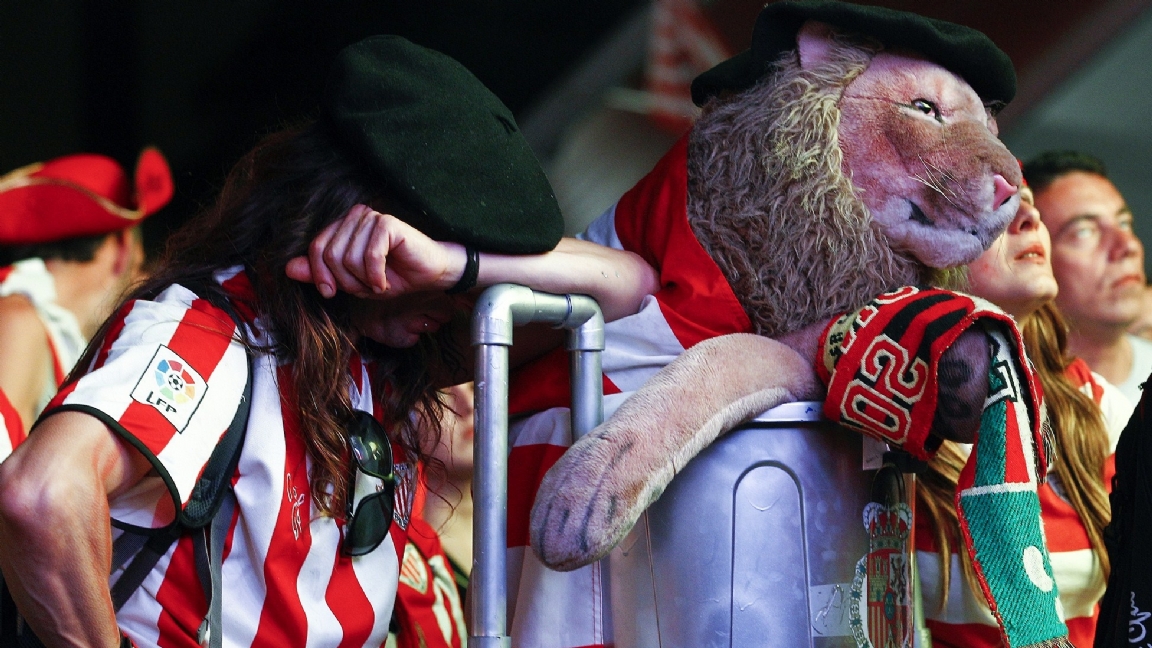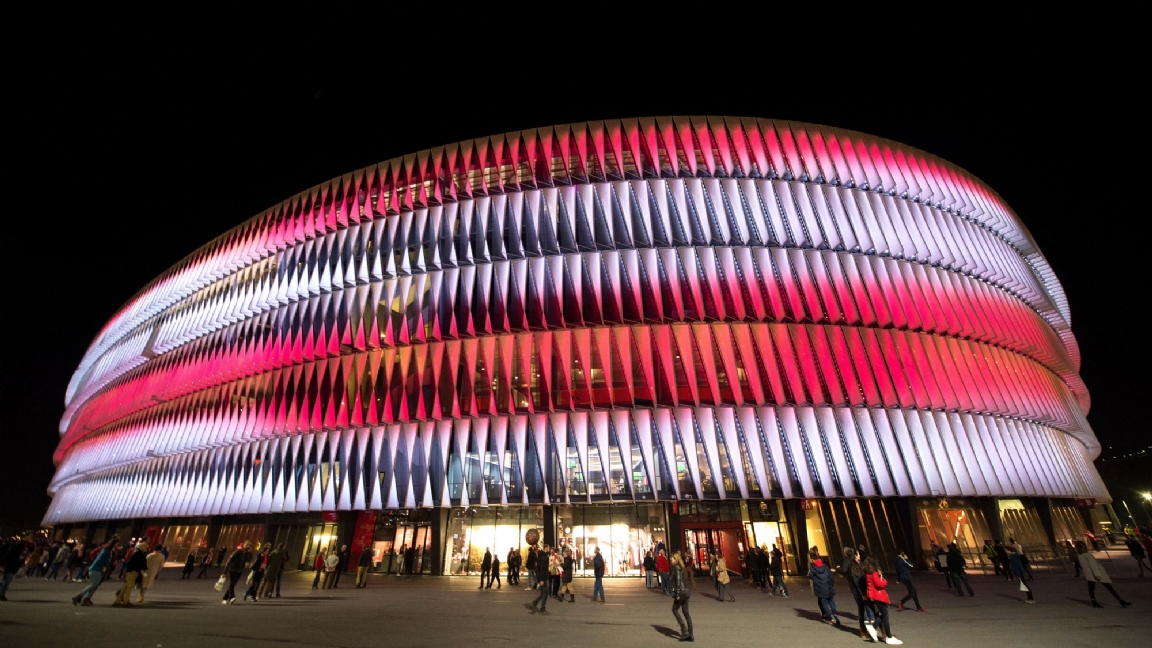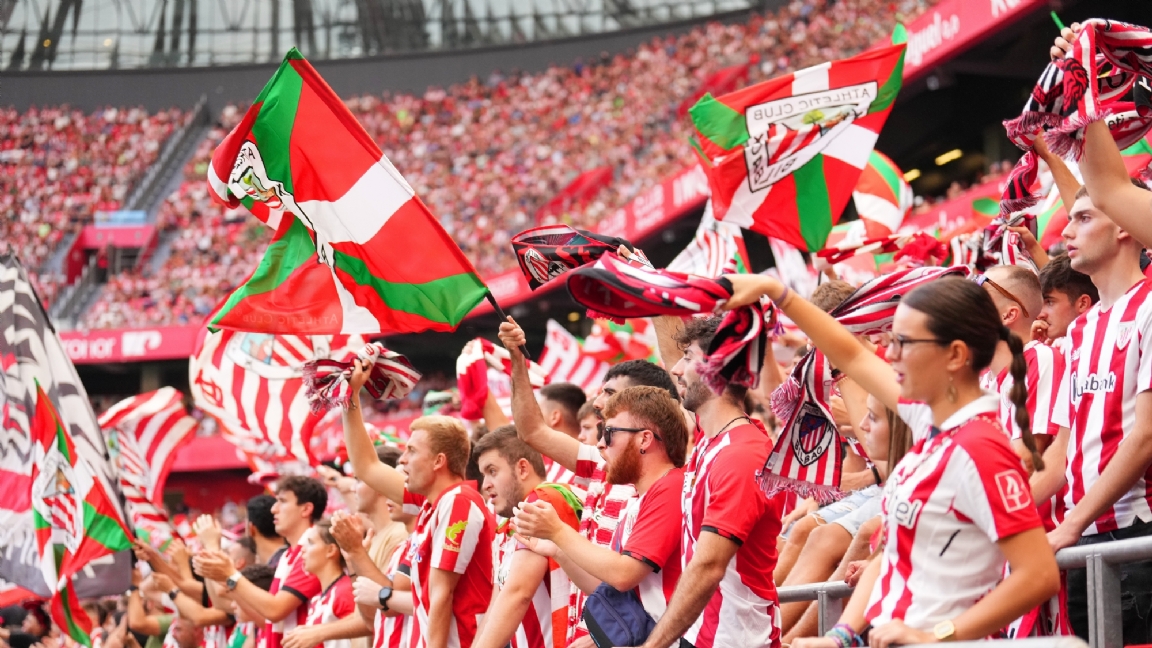![]()


In the shadow of football temples, billion-dollar balls and megalomaniac takeovers, clubs live on the margins. Where the enthusiast is still courted with history, character and sincere romance. For the section Cult clubs is reading Football zone from the fairy tale books of the football library. In this edition: Athletic Club, the regional club that manifests itself as a miniature national team due to the special policy.
By Kevin van Buuren
Despite the cult status of the Spanish club, Estadio San Mamés falls under the heading of ‘football temple’. Not least because the former version, since 2013 replaced by a state-of-the-art variant, by the fans La Cathedral was named. A classic, square-shaped stadium in Bilbao, whose famous arch has supported the cantilevered main stand since 1953, while that stand, however, carried the arch like a crown. Now a scaly tub with a semi-transparent facade towers over the city along the Nerbioi River, glowing in the dark and housing more than 50,000 people. With its modern character, the stadium fits seamlessly into the revolutionary cityscape, as if it came from the nearby Guggenheim Museum. For the people just such a connecting point as the infamous Zubizuri footbridge.

San Mamés glows in the dark.
The architectural policy is therefore in line with the guidelines of the local club. Athletic puts together the selection as if it were realizing a zoning plan for the city. Each player is in direct or indirect contact with the region of the Autonomous Community of the Basque Country, which also includes the Community of Navarre and the French Basque provinces of Labourd, Lower Navarre and Soule, directly through the bloodline or indirectly. This makes Club a small national team, in the middle of Spain. “The club may only field players who come from its own training, or training from other clubs in the Basque Country, or players born in Biscay, Gipuzkoa, Alava, Navarra, Labourd, Soule and Lower Navarra,” the statement reads. official website.
Short-lived foreign influences
Yet this meso-nationalism does not contribute to the emergence of the club. The region is introduced to football thanks to English migrant workers in Biscay. DailyEcho in 1889 reports on a football match between English seamen. Nine years later, Athletic Club, completely in British spelling, was founded by Basque students returning from their studies in England. In addition, they also set up a branch of the club in Madrid: Athletic Club Sucursal de Madrid. The Basques organize their matches in Lamiako, a neighborhood in Leioa. When Club participates in the very first edition of the Copa del Rey in 1902, it plays in blue and white uniforms. Also not invented in the region, but from the English Blackburn Rovers. Club wins that cup, with the help of the English football players who still play there frequently.
In 1910 the club colors change drastically. Selection player Juan Elorduy, who is making a trip to England, is instructed to score more kits. When the midfielder returns from the city of Southampton, he shows his fellow players and coaches red and white striped jerseys. Blackburn said he was sold out, and Elorduy chooses the clothing of local club Southampton FC. The Madrid concern also receives a load of the same uniforms and from then on goes through life as Rojiblancos, ten years before it declares its independence and officially changes its name to Club Atlético de Madrid. Meanwhile, Athletic moves to Bilbao in 1913, playing football in San Mamés; the cathedral. The club also decides in 1911 that the Copa del Rey win was the last with foreign influences: Athletic Club will compete with exclusively Basque players.
?? ???????????????? Juan Elorduy, Athletic Club player, traveled to England and brought back the first red and white shirts. They made their debut in Bilbao in 1910 and in our branch, in Madrid, in 1911. pic.twitter.com/fWY49NJsaP
— Atlético de Madrid (@atletienglish) February 19, 2023
The eternal top scorer
One of those own players is Rafael Moreno Aranzadi, born in 1892 in Bilbao. At the age of 21 he made his debut at Athletic, where he later became the club’s first official professional player. In addition, he scores the club’s first ever goal in San Mamés. As a little boy he was nicknamed ‘Pichichi‘: little duck. Only 1.53 meters tall, his narrow face often framed by the white bandana on his head. Pichichi scores 83 goals in just 89 appearances for the club; in total he would even have scored 200 goals in 170 games. He also plays for Spain at the 1920 Olympics, scoring a goal against the Netherlands. Aranzadi finally stops at the age of 27, a year later he dies of typhus.
Then the goalscorer has already left his mark on Spanish football in eternal ink. In 1914, 1915, 1916 and 1921 he won the cup with Athletic. And when in 1928, six years after his death, LaLiga is officially established as a national football league, the top scorer is invariably referred to as ‘Pichichi‘ named. Later also focuses Madrid newspaper Mark its own award for Spain’s top scorer: from 1953 the medium awards the self-proclaimed Pichichi award. The striker is also never forgotten in San Mamés. Captains of away teams playing football in the stadium for the first time are invited to place a bouquet at the statue of Aranzadi. In addition, a street is also named after the legend, adjacent to the stadium.
Rafael Moreno Aranzadi ‘????????????????’ ?? ?? On this day in 1913, the #AthleticClub legend made his debut! ?? 89 matches ? 83 goals ?? Find out more about the life and career of one of football’s most iconic talents ??https://t.co/B2evh1ZI9r
— Athletic Club (@Athletic_en) March 17, 2021
Big in its own way
Meanwhile, football life in Bilbao goes on as usual. Los Leones win the first national title in 1930 and supplement that with another national cup. A season later it even extends the double, in a season where Barcelona is a victim of the club’s record win: 12-1. The same result equals Club in its favorite competition: in the Copa del Rey of 1947, Celta de Vigo is also beaten 12-1. This happens four years after Club again claims the Spanish double. However, the success in the 1940s is not self-evident. During the Spanish Civil War between 1936 and 1939, the club collapsed financially and sportingly.
Then in 1941 the name is forced to change to Atlético Bilbao. Generalismo Francisco Franco this year bans the use of non-Spanish languages in the country. In doing so, he scraps the rule that only Basque players may be under contract. But Atlético Bilbao builds the club through its own youth and also finds a bright spot. Telmo Zarra is following in Aranzadi’s footsteps. Between 1940 and 1955, the striker scored 251 goals in 277 matches. His record of 38 goals in a single season was only broken in 2011 by Cristiano Ronaldo, who scored 46 goals for Real Madrid. Despite the influence of Dictator Franco, the Basque policy gains more strength under his eyes in 1958. Franco then personally watches the Copa final between Bilbao and Real Madrid. Bilbao wins 2-0 against the Real that will win the third European Cup I in a row that year. President Enrique Guzman immortalized the club’s identity with the famous quote: “Eleven villagers was all we needed to beat Real.”

San Mamés is usually colorfully filled with loyal supporters.
In order to continue the success with its own youth, and to honor the club’s concept of only fielding Basque players, Club opened Lezama in 1971. The training center and players’ home that can be compared to La Masía in Barcelona. The medium The Athletic (no relation) reports that twenty ten-year-old boys arrive at the center every year, of which an average of two will play in the first. A higher average than anywhere else. And with success. After Barcelona and Real Madrid, Athletic is the most successful club in Spain with eight championships and 24 national cups. In addition, together with the two giants, it is the only club that has never been relegated from LaLiga. The selection procedure may resemble that of your local amateur club, but this is reflected in professional standards that set an example for every other club.
